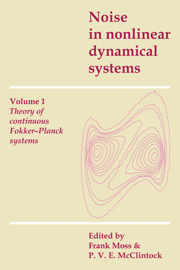Book contents
- Frontmatter
- Contents
- List of contributors
- Preface
- Introduction to Volume 1
- 1 Noise-activated escape from metastable states: an historical view
- 2 Some Markov methods in the theory of stochastic processes in nonlinear dynamical systems
- 3 Langevin equations with colored noise
- 4 First passage time problems for non-Markovian processes
- 5 The projection approach to the Fokker–Planck equation: applications to phenomenological stochastic equations with colored noises
- 6 Methods for solving Fokker–Planck equations with applications to bistable and periodic potentials
- 7 Macroscopic potentials, bifurcations and noise in dissipative systems
- 8 Transition phenomena in multidimensional systems – models of evolution
- 9 Colored noise in continuous dynamical systems: a functional calculus approach
- Appendix: On the statistical treatment of dynamical systems
- Index
6 - Methods for solving Fokker–Planck equations with applications to bistable and periodic potentials
Published online by Cambridge University Press: 05 January 2012
- Frontmatter
- Contents
- List of contributors
- Preface
- Introduction to Volume 1
- 1 Noise-activated escape from metastable states: an historical view
- 2 Some Markov methods in the theory of stochastic processes in nonlinear dynamical systems
- 3 Langevin equations with colored noise
- 4 First passage time problems for non-Markovian processes
- 5 The projection approach to the Fokker–Planck equation: applications to phenomenological stochastic equations with colored noises
- 6 Methods for solving Fokker–Planck equations with applications to bistable and periodic potentials
- 7 Macroscopic potentials, bifurcations and noise in dissipative systems
- 8 Transition phenomena in multidimensional systems – models of evolution
- 9 Colored noise in continuous dynamical systems: a functional calculus approach
- Appendix: On the statistical treatment of dynamical systems
- Index
Summary
Introduction
The Fokker–Planck equation (FPE) deals with those fluctuations of continuous variables which stem from many tiny disturbances, each of which changes the variables in an unpredictable but small way. One therefore has to add noise forces to the deterministic differential equations describing the motion of the variables of the system. This can be done by including these noise forces as additive terms on the right hand sides of the equations of motion (additive noise) or by including them as fluctuating prefactors of some terms (multiplicative noise). Thus, instead of deterministic systems, one has to deal with stochastic differential equations. The properties of the noise forces are important for defining the stochastic differential equations. If the noise forces are δ correlated in time one speaks of white noise, otherwise the term colored noise is used. For white noise the stochastic differential equations are called Langevin equations.
To obtain numeric solutions of these equations one may simulate them on a digital computer or build an analog circuitry simulating the equations electronically. Analytic solutions can be given if the Langevin equations are linear and have additive noise terms. Then, using Green's function of the deterministic system, one can write down the solution of the Langevin equation. If the Langevin equation is nonlinear, it is often impossible to solve it analytically. The best way of treating a nonlinear Langevin equation consists in transforming it to an FPE.
- Type
- Chapter
- Information
- Noise in Nonlinear Dynamical Systems , pp. 191 - 224Publisher: Cambridge University PressPrint publication year: 1989
- 1
- Cited by



